I broke one of my own rules in that I cut it out at 10pm, which is the not best thing to do - however no harm done. Also I did all the markings. Once I cut out - I have to mark all pattern pieces and then it can "rest".
Here is a look at the tailor tacks. Stitchywitch had a post last week about marking fabric, Making Marks and she concluded that she disliked doing tailor's tacks, so she boldly did the many, many marks on her very lovely dress with chalk. Hmm. interesting. And probably really helpful on that pattern. Her dress is adorable and I wish I had time to make that pattern and/or somewhere fun to wear it. I confess I have used chalk on some things with a lot of pleats. But in general - I support the tailor tack! anyone with me?
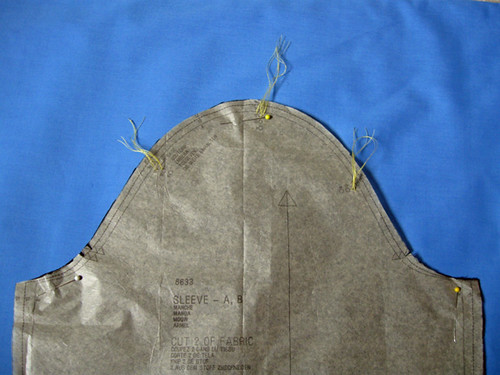
I generally do 1 loop and snip, but for purposes of this photo, 2 loops and about 2" per tack
so they would show in the photo.
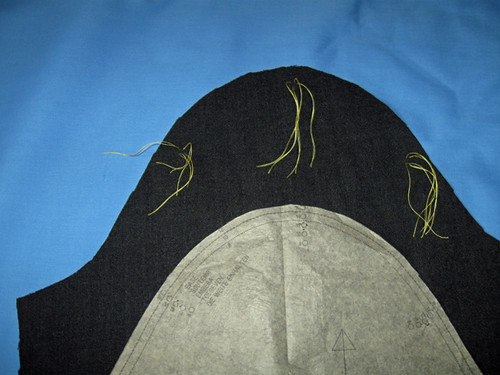
Next I carefully separate the two sleeves, and snip the threads, so I have threads on both sleeves. Of course I have on multiple occasions pulled the top piece off without snipping, with leaves you with one piece marked and the other blank. No harm, just have to redo. Like any other error - make it a few times and you will teach yourself not to do it.
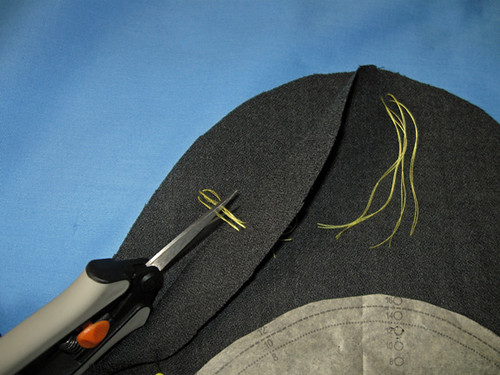
Lastly, I do use chalk here to mark the inside of the sleeve. For a fabric like this wool crepe the right and wrong sides are indistinguishable, so it is easy to get one piece turned over and then sewn up, with the result being two left sleeves. Don't tell me you haven't done that :)
After separating the sleeves and snipping the tailor's tacks, I put a chalk X on the inside of the sleeve. Also I have put chalk hash marks on the double notches just for another visual aid. It is strangely enjoyable to make the chalk X, kind of like coloring outside the line instead of always being careful and accurate.

In the course of a lesson recently, I mentioned to one of my sewing students, "well you can see that is the back piece because it has double notches" and she stopped me there. If you are new to sewing, take a look at the pattern pieces and see that this is the case, generally single notches are for front pieces, double notches for back pieces, triple notches are often seen on the center back seam. Thus the sleeve has double notches where it attaches to the back of the jacket and single notch where it attached to the front. Not always exactly this way - but there is an order to the notches.
Here is the pattern envelope and jacket that I made last year from this same pattern.
In this case it was for a 2-piece dress and jacket.
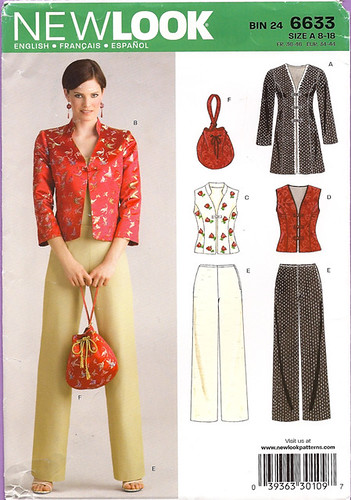
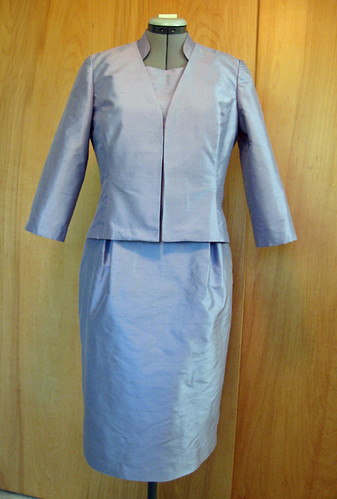
Lastly, here is a finished view of the dress I was working on last week, where I posted about invisible zippers. This is Simplicity 2550 and I really like this pattern, it is very flattering on a variety of figures. It is a bit wrinkled as it was worn to a wedding on Sat. Cotton interlock knit on top and cotton sateen in navy blue on the bottom.
no garden photo today - not much blooming, it is starting to rain, lots of leaves to rake and generally heading into the least interesting time of year here, gardenwise.
Time to stay inside and sew!












I agree with you, tailor tacks 100%. I think they are quickest and easiest. Won't leave a mark and so easy to remove.
ReplyDeleteI'm with you on tailor's tacks - I use them all the time. You can see them on both the right and wrong side of the fabric and they are quick to remove. I also love wool crepe - it's beautiful to work with and wear.
ReplyDeleteAnother great informational post. I have never used tailors tacks. Perhaps I should give it a try. I like what Eugenia said about being able to see the markings on both sides too!
ReplyDeleteHI Beth. Just about to start cutting into some wool crepe for the first time and googled 'how to tell right and wrong side of wool crepe'. So glad I found your blog as a result. Not only reassures me about the indistinguishable sides but confirms that I should be doing tailors tacks too. Always feel like they will take longer than chalk marks but actually they will be useful to have the markings on both sides of the fabric in this case! Thank you so much! :-)
ReplyDelete